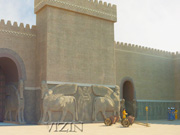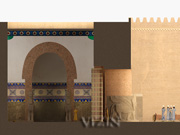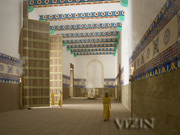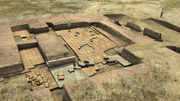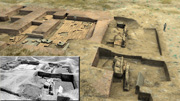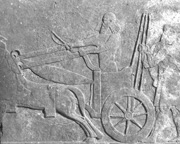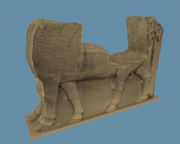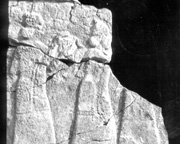This section focuses on two of the areas
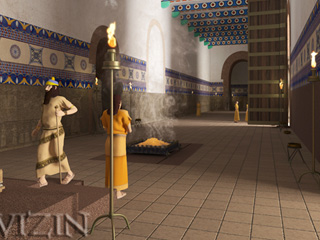 Project Demo
Project Demo
Low-res version of an animation for the Williams College Museum of Art ancient gallery to explain the context and iconography of their two palace reliefs (the first such reliefs ever to come to this country);
© 2011 Learning Sites, Inc.
The Northwest Palace, built primarily by Ashur-nasir-pal II (883-859 BCE), is the largest and most extensively excavated of the palaces on the Nimrud citadel. Excavations were conducted by the British sporadically between 1854 and 1882, and then more seriously beginning in 1949. Under the British School of Archaeology in Iraq and the British Museum, additional areas of the Northwest Palace were traced and mapped, doubling the previously known extent of the building. Mud brick walls and arched doorways were reconstructed, and bas-relief fragments were restored in situ. In the 1970s, a Polish team documented the whole citadel site in photographs, including all of the sculpture, and surveyed the site and recorded it in plan and elevation. Since the 1970s, Iraqi teams have continued work on the palace, including the discovery of tombs of women of the Assyrian royal family below the floors.
The Northwest Palace has about 100 rooms, more than 20 of which were lined with slabs of stone covered with bas-relief sculpture. Many of the reliefs depict large standing or striding figures, mostly of kings, attendants, tribute bearers, and winged geniuses. Other slabs depict battle and hunting scenes that advertise the accomplishments of the king. Inscriptions extolling the king’s ancestry and deeds are carved across and between the figures and scenes. Major entryways were flanked by pairs of lamassu. Some of these sculptural elements remain at the site, on the walls or in the site museum, but most was dispersed in the 19th century to museums and private collections around the globe – 320 documented reliefs or fragments in 80 different collections.
The bas-reliefs and the lamassu from the Northwest Palace are among the most familiar images from ancient Mesopotamian art. Not only do these images give us some of the most accomplished artistic expression of the ancient world, but also, in combination with the inscriptions, they give us deep insight into the practices of the Assyrian court and culture. Indeed the Northwest Palace, with its arrangement of spaces and its impressive sculptural decoration inspiring awe of, and service to, the ruler, can be seen as the model for subsequent Assyrian palace design.
Project |
Paley realized that a digital visualization of the palace could be not only a tool for testing his own ideas, but also a resource to be made available to scholars, educators, and students so that they might better appreciate the architectural design and the grand sculptural program of this important ancient monument. In addition, he saw the potential for shedding new light on, and raising new questions about, circulation in the building, lighting, and the functions of rooms and spaces. At the same time, such a resource could provide a synthesis of the diverse data, research, and interpretations accumulated in the 150 years since the site’s discovery by explorer Sir Austen Henry Layard.
Solution |
The Throne Room suite of the Northwest Palace was reconstructed based on already published plans, drawings, and black-and-white photographs. It was known that the bas-relief images on the walls had been colorfully painted and that colorful decorative borders had circled the room above the reliefs. Getting accurate color in the reconstruction required special tactics, including checking the British Museum’s archive of Layard’s notes from the 1840s, obtaining new color photographs of the remains at Nimrud and the pieces in museums around the world, and analyzing minute pigment samples from some of the sculptures.
click on the images to enlargeAs the project progressed, it became clear that, as hoped, the reconstruction of the building and the reuniting of the images using the new real-time interactive technologies were meeting and exceeding expectations in terms of usefulness and versatility. They allowed scholars to gain insights into the iconography of the bas-relief and the probable functions of spaces, as well as to revisit questions concerning established views about the building’s construction and decorative details. The model also is serving its purpose as a teaching tool by being used in classrooms directly off the Web; in addition, part of project’s results was extracted and adapted to QTVR technology to be used in the elementary school classroom. At the college level, the model is being used to experiment with CAVE and Immersadesk™ technologies. Learning Sites continues to work with the University at Buffalo (SUNY) to expand the capabilities of the model on these high-end platforms.
The digital reconstruction and virtual reality model of the Northwest Palace at Nimrud are well on their way to becoming the basis for a complete digital publication of the all the remains from this building complex. The larger plan for this project includes expansion to include other decorated spaces in the Palace and exploration of the relationship of the Northwest Palace to other buildings on the Nimrud citadel, such as
- the Northern Temples and Ziggurat
- the citadel wall
- the unpublished area in the vicinity of the remains of the Central Palace.
Setting
In the 1970s, an Iraqi excavation team continued excavation of the Northwest Palace, and a Polish team, headed by Janusz Meuszynski, documented the whole site in photographs, including every sculptural relief that remained in situ, as well as the fallen pieces. This was to be his dissertation, only part of which was completed. (The doctorate was awarded post mortem.) The architect of the Polish team, Richard P. Sobolewski, surveyed the site and recorded it in plan and elevation.
In 1974, the Polish Center of Archaeology returned to re-excavate the site of the Central Palace of Tiglath-pileser III (744-727 BCE), located just south of the Northwest Palace. The purpose of the Polish mission, headed once again by Meuszynski, had been to re-excavate the center area of the citadel, rediscover Tiglath-pileser’s palace and several other buildings in that area that had been located by Layard and his team. After the death of Meuszynski in 1976, the Polish work at Nimrud ceased. Sobolewski began a collaboration with the late Samuel M. Paley (formerly Professor of Classics, University at Buffalo, SUNY) to research and write up the bas-relief sculptures not covered in Meuszynski’s publications.
Project |
There are too few examples of Tiglath-pileser’s bas-reliefs in the total corpus of Assyrian sculpture to allow the results of the Polish project to remain unpublished. The Polish finds are an extremely valuable resource. What we now know of Tiglath-pileser’s Palace is that many of the themes of earlier and later sculpture are to be found on its bas-relief decoration. And, there are new motifs and the syntax of the sculpture, the way scenes were portrayed, and the placement of the vignettes of individual parts of scenes on the faces of the slabs, and details of the garment decorations have their own character and style.
An additional and disturbing fact is that individual bas-reliefs (some with inscriptions) have been appearing on the antiquities market, looted from the site museum storerooms at Nimrud. Some of the bas-reliefs have been broken up into pieces to obscure their origin and in order to obtain more money from several rather than from the one original fragment. Many of the better examples of bas-relief from this excavation are now on the international art market as a result of illicit activities (theft) at Nimrud subsequent to the first Gulf War of 1991.
Learning Sites was called in to create a comprehensive online digital publication of the Polish excavations so that all of the finds could be displayed for global research and to definitively document which sculptures did originate from Nimrud in order to slow their illicit purchase.
click on the images to enlargeSolution |
Preliminary Webpages have already been created to display the computer visualizations of the remains, photographs, drawings, descriptions, and analyses prior to their full and final publication.
Reference
Page Created: January 16, 2012
Page Updated: January 25, 2012
URL:
Page Author: The Institute for the Visualization of History
